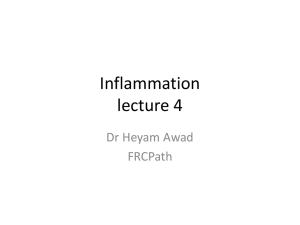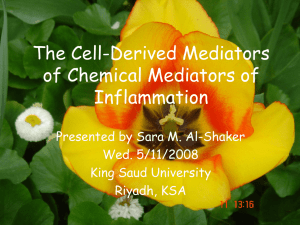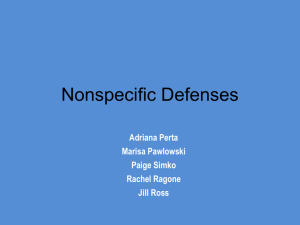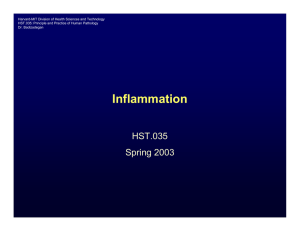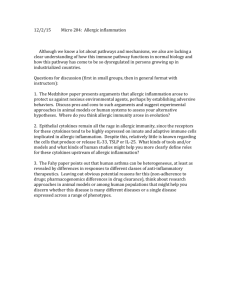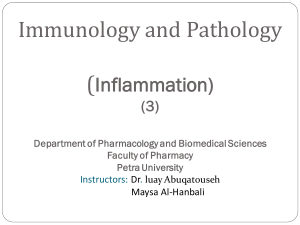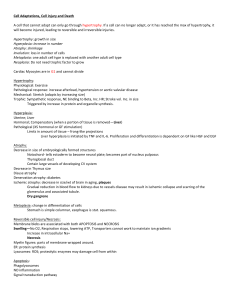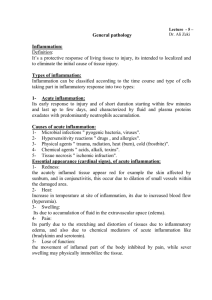Inflammation 4
advertisement
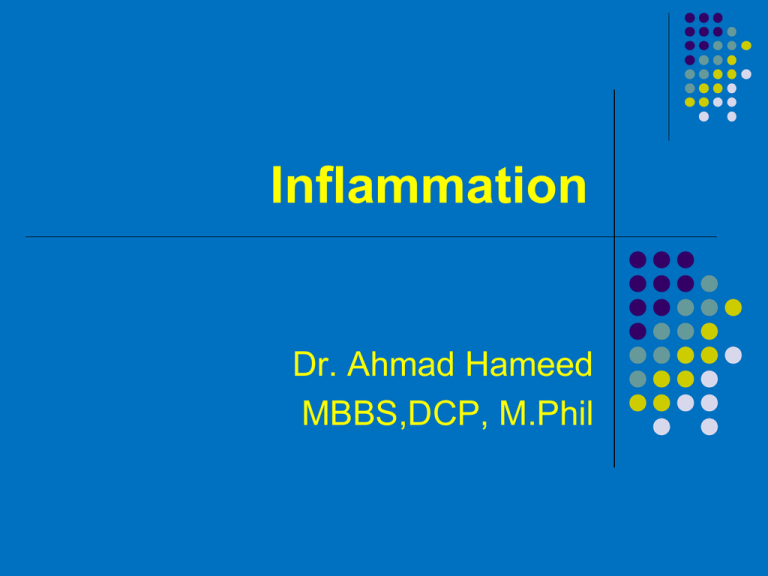
Inflammation Dr. Ahmad Hameed MBBS,DCP, M.Phil Cytokines Polypetide products of many cell types that function as mediators of inflammation and immunity Some stimulate bone marrow precursors to produce more WBCs Some mediate communication between WBCs(Interleukins) Major cytokines in acute inflammation(TNF, IL-1) and chronic inflammation (IFN-γ ,IL-12) TNF & IL-1 Produced by macrophages, mast cells, endothelial cells Stimulated by microbial products, immune complexes, products of T-lymphocytes Endothelial effects Endothelial activation expression of adhesion molecules WBC binding & recruitment Procoagulant activity by TNF Increase in IL-1,IL-6,IL-8,PDGF, eicosanoids Fibroblast effects Activates tissue fibroblasts Increases proliferation, production of collagen &ECM Systemic Effects Fever Lethargy Increased sleep Decreased appetite Hepatic synthesis of acute phase proteins Metabolic wasting Corticosteroids Synthesis Neutrophil release in circulation Fall in blood pressure The roles of cytokines in acute inflammation. The cytokines TNF, IL-1, and IL-6 are key mediators of leukocyte recruitment in local inflammatory responses and also play important roles in the systemic reactions of inflammation. Chemokines Family of small 8-10 kDa proteins Helps in recruitment and activation of Leukocytes Responsible for anatomic distribution of B & T lymphocytes in different areas of lymph nodes & spleen Mediate their activities by binding to specific G-protein coupled receptors on target cells. Receptors: CXCR4, CCR5 Chemokines CXC One amino acid separating the cysteines Act primarily on neutrophil IL-8 Produced by macrophages, endothelial cells, mast cells, fibroblasts Produced in response to microbial products, IL-1 and TNF CC Adjacent cysteine residues MCP-1, MIP-1α RANTES Eotaxin ROS Produced by NADPH oxidase in neutrophils & macrophages Activated by microbes, immune complexes, cytokines With in lysosome destroy phagocytosed microbes and nectrotic cells At low levels, increases cytokines & adhesion molecule expression ,destroy phagocytosed microbes & necrotic tissues At high levels, cause tissue injury by endothelial damage, breakdown of ECM because of protease activation and an Direct injury to other cell types ,inactivation of antiproteases Protective mechanisms( Catalase, Superoxide dismutase & Glutathione) NO Short lived, soluble, free radical gas Produced by neurons, macrophages & endothelial cells nNOS, iNOS (IL-1, TNF, IFN-γ, bacterial endotoxins) also present hepatocytes, cardiac myocytes, resp epithelial cells, eNOS Functions Cytotoxic to microbes(Microbicidal) Vasodialation ↑ Increase vascular permeability Inhibits platelet adhesion,aggregation & degranulation Inhibits WBC adhesion & recruitment ↓ Decrease cellular response Lysosomal Enzymes of WBCs Capable of phagocytosis and tissue damage Acid proteases Active only within phagolysosomes Neutral proteases E.g. Elastase,Collagenase,Cathepsin Active in ECM, degrade elastin, collagen & other matrix proteins Convert C3 & C5 to C3a & C5a Can convert HMWK to Bradykinin Destructive Effects of Lysosomal Enzymes Proteases are checked by Anti-proteases e.g α1antitrypsin is inhibitor of neutrophil elastase and α2 – macrogloblin α1-antitrypsin deficiency in the lungs cause severe panacinar emphysema Neuropeptides ( e.g Substance P) Initiates inflammation Transmit pain signals Regulate vessel tone & thus vascular permeability Secreted by sensory nerves (lungs, GIT) and leukocytes. Stimulation of secretion by endocrine cells Regulate blood pressure
